By Mike Tanner, Photos by Mike Tanner
VIRGINIA BEACH, VA -- The dull clank and rattle of excavating buckets has faded away. Huge trucks no longer rumble across bare dirt. Massive bulldozers root and roar their way across other pastures now. At Red Wing Lake Golf Course, near Virginia Beach, Virginia’s famous resort district, Mother Nature is back in charge.
With new underground plumbing in place and earth rearranged to architect Kevin Tucker’s specifications, the most important task remaining in the venerable course’s renovation is for the grass to grow into a thick, green carpet of healthy turf. The man who is happily watching the grass grow is Superintendent Kevin Bennington.
“Fall was very good weather-wise and we’re hoping that spring will be the same,” he said in March 2006. The greens are in; now we’re just waiting for warmer weather for the Bermuda grass in the fairways to come out of dormancy and start growing.”
Bennington, a member of the Golf Course Superintendents Association of America, and his greens-keeping staff stayed at Red Wing throughout the nearly 10-month construction phase of the renovation, which started in January of 2005, approximately two months later than originally planned.
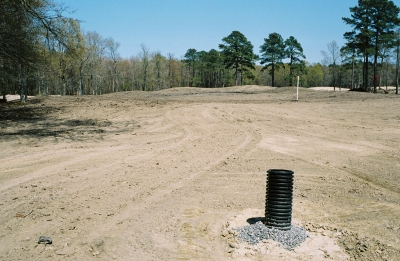 |
| The par-5 second hole, April 2005. |
“Our crew did all the grassing. That saved $300,000 that otherwise would have been part of the project budget,” explained Bennington.
Red Wing’s new greens are built to United States Golf Association specifications and covered with a 50-50 blend of A-1 and A-4 bentgrass. Generally considered a cool-climate turf grass, new varieties of bentgrass are heat-tolerant and disease-resistant. Using a mixture of two varieties provides additional insurance against catastrophic loss should something go wrong.
Fairways were seeded with a new type of Bermuda grass known as Riviera.
“It’s cold-tolerant, an aggressive grower and resistant to spring dead spots,” said Bennington.
To protect the integrity of the shaping and to control erosion from rainwater runoff, “We sodded the teeing areas, bunker edges, green banks and pond banks with 419 Bermuda grass,” he added. “We also seeded the second, fifth, sixth, seventh and eighth holes with rye grass because they were completed in September and it was too late for Bermuda grass.”
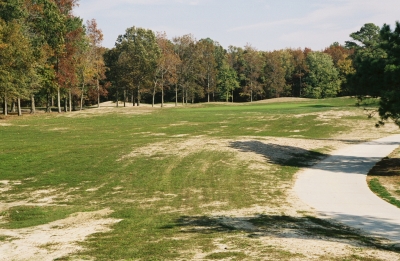 |
| Red Wing's new style: Where an expansive putting surface protected by three bunkers once stood, a smaller, bunkerless green backed by mounds awaits at the par-5 second hole. |
Not only did Bennington’s crew help reduce costs, their presence provided extra pairs of eyes during the construction process.
“We know where everything is buried,” Bennington said. “Even though we have ‘as-built’ drawings, it’s a real benefit to have watched the installation of underground systems.”
New plumbing — irrigation and drainage systems — were among the highest priorities during Red Wing’s renovation. Using fill material generated by the creation of new wetlands areas and ponds on the property, fairways were elevated above a new drainage system capable of easily handling the rainfall equivalent of a five-year storm.
Discussing the new irrigation system brings a noticeable tone of enthusiasm to Bennington’s voice.
“The difference [between the new system and the 30-year-old pipes and pumps it replaced] is amazing,” he exclaimed. “Using computer controls, we can program 13 different satellite boxes that run 64 separate stations and coordinate the individual sprinkler heads. “
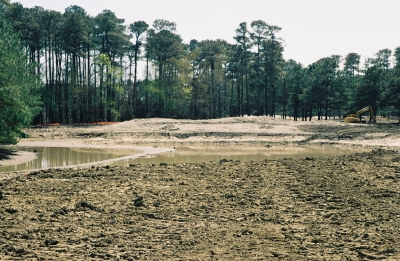 |
| A vestige of the par-3 sixteenth hole's former shoreline is visible in the left center of the photograph taken in April 2005 during the construction phase of Red Wing's renovation project. |
Water can be directed to putting surfaces alone, to the slopes surrounding the greens alone, or both at the same time. Pairs of sprinkler heads along the fairways can be sequenced to “walk” the spray of water from tee to green.
The new irrigation system incorporates the principle of “fertigation,” in which fertilizer and other turf maintenance products are mixed into the irrigation water and applied where needed. In addition to providing pinpoint control, the process eliminates waste and potential runoff problems associated with applying granular material on the ground.
“It’s just like an IV drip,” said Bennington, who added that it was invaluable during periods of the grow-in process when heavy rains precluded the use of motorized equipment on wet fairways.
In addition to the challenge of coordinating his projects with Mother Nature’s watering schedule, Bennington had a close encounter with armyworms, a larval moth caterpillar with a hearty appetite for tender grass.
During late summer 2005, after the grass on some of the finished holes had started growing, a voracious horde of the segmented crawlers appeared behind the sixteenth hole and marched through the woods to the fifteenth hole and onto the eleventh.
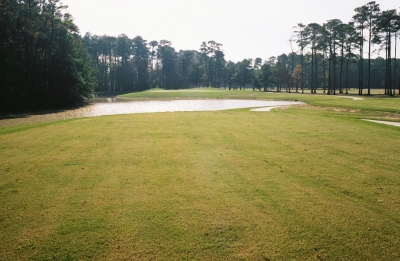 |
| The sixteenth hole in November, 2005. |
“We were alerted by a flock of crows that was feeding on them,” said Bennington. “There were so many caterpillars, you could actually hear ‘em.”
He wasn’t totally surprised, having seen a similar phenomenon during his previous tenure at Kingsmill Resort & Spa in Williamsburg, Virginia. Between the hungry crows and a little human intervention, the armyworms left the field of battle in defeat.
Surprises, large and small, are part of any renovation project. For Richard Nutter, Golf Course Administrator for Virginia Beach’s Parks and Recreation Department and a prime mover in the project, one unexpected moment occurred during the demolition phase.
As a bulldozer bit into the first green to be leveled, the excavated portion revealed a sub-surface drainage system beneath the putting surface.
“The pipes looked like they had never been used,” said Nutter.
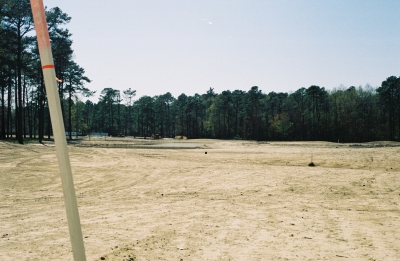 |
| The par-5 ninth hole, April 2005. |
For years, people had associated poor drainage and susceptibility to turf disease on Red Wing’s greens to the assumption that they were the “push-up” type, constructed by simply piling up earth from the golf course site.
Instead, a thin layer of impermeable material — “an orange line” according to Nutter — had formed and prevented water from properly percolating through the green to the drainpipes.
“They [drainpipes] were in the plans,” said Nutter, but based on the way the greens retained water, “We thought they hadn’t been installed.”
More than 30 years have passed since Red Wing opened and today’s construction techniques are much more technically sophisticated. Multiple tests are performed to ensure that the intermediate layer of material between the soil mix on top and the drainage level on the bottom permits water to move freely.
Nutter has plenty of praise for both the architect and the construction company responsible for Red Wing’s makeover.
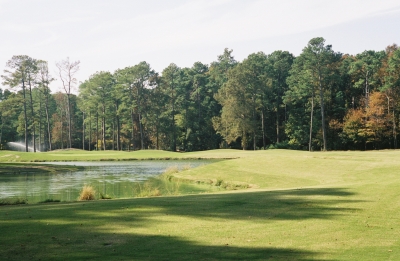 |
| The expanded (from the small peninsula on the left back toward the viewer) water hazard on the par-5 ninth hole creates new strategic options as well as increasing the course's capacity to handle storm water. |
“[Architect] Kevin Tucker brought in a product we’re very happy with,” he said. Speaking of the golf course construction company, Nutter added, “Landscapes Unlimited worked with us very well.”
Nutter is also pleased with they way Red Wing’s renovation project benefits the environment.
“We created four interconnected wetland benches that are landscaped with native vegetation and are linked to lakes on the course. Nearly 95% of rainfall and irrigation water is captured and directed to the lakes. If necessary, storm water from Red Wing Lake can flow into the golf course rather than surrounding residential areas,” Nutter explained.
Creating new wetland areas and expanding the dimensions of existing lakes solved two problems for architect Kevin Tucker of Nashville, Tennessee-based Kevin Tucker Design Group. Drainage was improved and the excavated material was used to build up tees, greens and fairways. Because Red Wing occupies a flood plain, material from outside the site could not be trucked in.
One side effect of using material excavated from existing lakes was that thousands of golf balls were dredged from their muddy beds and distributed over the course. Now slumbering under fairways instead of under water, they might occasionally turn up at the bottom of a particularly deep divot.
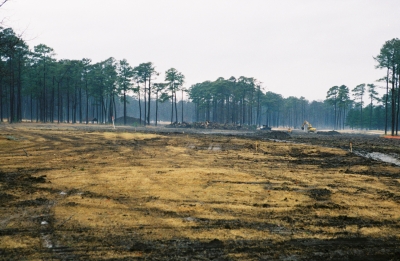 |
| The par-5 fourteenth hole, January 2005. |
Interviewed by cell phone as he piloted his car from Nashville to a renovation project on an Air Force base near Little Rock, Arkansas, Tucker sounded upbeat about his experience at Red Wing.
“Everyone worked together extremely well,” Tucker said. “Landscapes Unlimited had worked in the area before, so they knew exactly what to expect from the soil. And the Red Wing staff worked their behinds off doing the turf planting.”
Asked about juggling the demands of multiple projects, Tucker described a typical two-or three-day site visit.
“I’d come in and do a walk-through, making notes. Then I’d meet with Landscapes Unlimited Project Supervisor Brett Lacey and visit with their shaper. And I’d meet with the city’s onsite representative Jim Beachum to discuss financial and quality control items.”
Tucker was at the course in Virginia Beach every week during 2005 from February through the end of September. He plans to return again after the grass has grown in to set fairway perimeters and mowing patterns with Kevin Bennington.
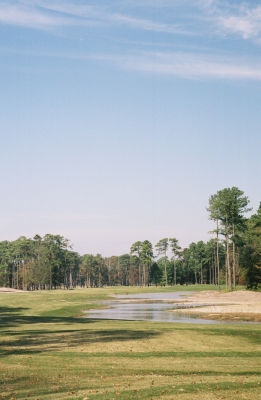 |
| A new pond and wetlands area created on the right side of the par-5 fourteenth hole adds an element of danger for slicers and connects the golf course's storm water management system to Red Wing Lake. |
A veteran of several dozen renovation projects, Tucker found the Red Wing job to be thankfully free of major setbacks. Finding drainage systems under what were thought to be push-up greens wasn’t that unusual.
As Tucker put it, “Discovering a sinkhole and losing a bulldozer in it is a surprise. There weren’t any showstoppers on this one.”
The architect remembered a similar experience that occurred in the mid-1990s while he was directing a renovation project near Mobile, Alabama. Two track hoes became mired in an area of boggy ground and “it was a 36-hour ordeal while we worked to save the equipment.”
Tucker thinks the new version of Red Wing won’t be an ordeal for players; in fact, he believes it’ll be more user-friendly than before the renovation.
“It’ll be a good test for low handicappers from the championship tees. The wide fairways and berms along the perimeters will help high handicappers keep the ball in play. Everybody should benefit from the improved drainage, with drier fairways and fewer playing days lost to wet conditions.”
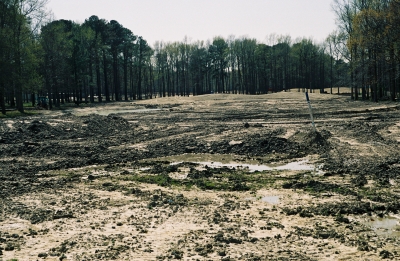 |
| The par-3 eighth hole, April 2005. |
In hindsight, would Tucker do anything differently?
“We could have added more length, but that would have meant encroaching on some existing wetlands. That would have required more permitting time and additional expense, so we didn’t take that route. Overall, we maintained the basic integrity of George Cobb’s routing, so there’s still that flavor, and I’m happy with that.”
Changing a golf course inevitably leads to changes in the way players view the course. Tucker thinks golfers who knew the old Red Wing will appreciate the newer, drier, better-conditioned Red Wing. Those who never played the original will likely appreciate features that are still present.
“The golf environment [at Red Wing] is a real stroll in the park, uncompromised by housing,” said Tucker. “The course is challenging, but fair, not all tricked up.”
Golfers won’t be able to see for themselves until sometime in late July or early August 2006 when Red Wing reopens. The grass still needs time to establish itself and some other items remain to be finished.
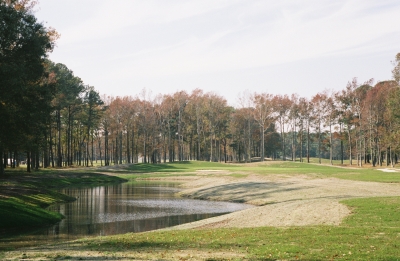 |
| The new par-3 eighth hole sports a rare bunker and a water feature added to improve drainage. |
The new maintenance building has yet to be completed and Kevin Bennington is hoping that once the rest of the invoices are paid there might be some money left over in the project budget for new mowers and other turf maintenance equipment.
Although it wasn’t part of the golf course renovation budget, the clubhouse will be getting new carpet and a fresh coat of paint. The thirty-year old building is showing its age, but the city’s money is being spent where it counts — on the course.
So if Mother Nature cooperates with fair days and the grass grows thick and healthy, Red Wing Lake Golf Course will be a tranquil haven once again, where the quiet is disturbed only by the sound of club face meeting golf ball and the occasional expletive — this being golf, after all.
Details:
Note: The author lives less than three miles from Red Wing’s first tee and has been playing the course regularly, if not always well, since 1979.
Look for more reviews of Virginia Beach area golf courses down below.
| Related Links | Comments on this article? | |
|
Maryland National Golf Club Hollow Creek Golf Club Rocky Gap Resort PB Dye Golf Club in Ijamsville Whiskey Creek Golf Club |
E-mail Jeff Rendall, Editor: jrendall@golftheunitedstates.com |












